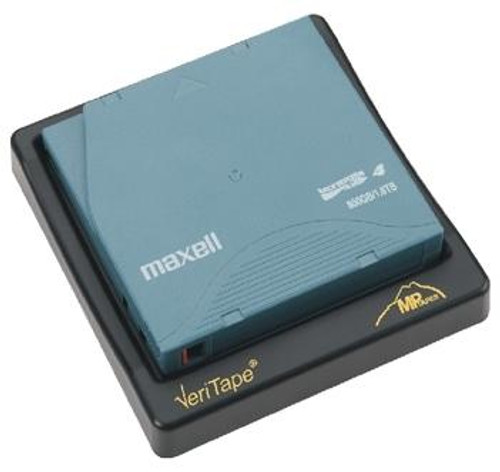VeriClean LTO Tape Cleaner
Since the first LTO cartridge shipped in 2000 the capacity of a cartridge has increased twenty-five-fold. Despite this dramatic increase in capacity, the physical dimensions of the cartridges never changed. The increase in capacity is, in large part, due to the increase in bit density.This high density recording makes later generation tapes increasingly vulnerable to contamination.
Even very small particles can cause problems.
The picture on the right shows a small area of a recorded LTO tape. The slanted lines in the center contain servo data that are used by the drive to find the location of the data tracks. The data tracks are located on both sides of this servo band.
The diameter of the brown particle is less than 100 μm (less than the thickness of a sheet of copy paper). But due to the high density of the recorded data, a particle of this size renders hundreds of bits unreadable.
The error correction circuitry of the drive would not be able to recover the data even with this tiny degree of contamination.
Removing the contamination without damaging the tape
High capacity tapes are delicate. It is paramount to use only proven and trusted technologies to clean the tapes. Our technology was developed in cooperation with a major tape library company and was thoroughly tested by all media companies.
When to clean tapes
Which tapes should be cleaned and when should they be cleaned?
- New tapes before their first use: New tapes can carry significant amounts of slitting debris. The debris is generated during the manufacturing process when the tapes are cut into ½ inch wide stripes.
- Tapes that are returned from an offsite storage facility: Although most storage facility go to great length to prevent contamination, contamination still can occur at the storage facility or during transportation.
- When an "abort" due to a write error cannot be tolerated: If data cannot be written reliably to tape, the tape drive will stop and the write command fails. The most likely reason for a write command to fail is contamination of the media or the drive. Using a clean tape increases the success rate.
- After a permanent read error occurs: Contamination of the media can prevent a tape drive from recovering data on the tape. If the tape contains critical input data the results can be disastrous. Cleaning the failing tape may allow the tape drive to read the data.
- After changing the capacity of a cartridge: The capacity of LTO and 3592 cartridges can be set to values less than 100% in order to increase the performance of partially filled tapes. Subsequently increasing the capacity may cause a serious problem. IBM issues this stern warning: "If the Capacity Proportion is increased it is possible that a debris dump may exist at the previous logical end of medium. This may cause a defect when attempting to write through that area." [IBM Documentation GA32-0928-01 page 166] Cleaning the tape will remove this "debris dump".
The Cleaning Technology
The cleaning method: Tape cleaning has a long history. Of the methods tried historically, perpendicular cleaning has proven the most effective. This method removes debris from tape with the use of a cleaning blade that is mounted perpendicular to the tape. As the tape moves past the blade, debris is removed from the tape and collected by the blade.
Using a Cleaning blade
The drawing illustrates this basic principle. A carbide blade contacts the tape to remove debris. The wrap angle of the tape is very shallow and the blade barely touches the tape. This prevents the blade from damaging the tape.
Cleaning the blade - Debris that is collected on the blade is removed by a brush after every cleaning cycle.
Self sharpening blade: The wear of the blade is controlled in a manner that the blade is self sharpening. As the cleaning edge wears, a new edge is created, keeping the blade sharp throughout its life cycle.
Maintenance free operation
The biggest problem with conventional blade cleaning methods is uneven wear. Sharp, Irregular edges of grooves cut into the blade by the tape can cause tape edge damage. Our proprietary technology moves the blade perpendicular to the tape after each cleaning cycle. The blade wear is controlled to avoid all sharp edges. The blade Stays sharp and does not damage tape even after hundreds of thousands of cleaning cycles.
| Specifications | |||
|---|---|---|---|
| Model Number: | VC-LTO | ||
| Dimensions (LxHxD): | 9.25 x 5 x 12.75 (in) / 235 x 127 x 324 (mm) | ||
| Weight: | 15 lbs. (6.8 Kg) | ||
| Tapes: | LTO 1-8 | ||
| Cleaning Time: | From < 4 min (LTO1) to ~ 6 min (LTO8) | ||















